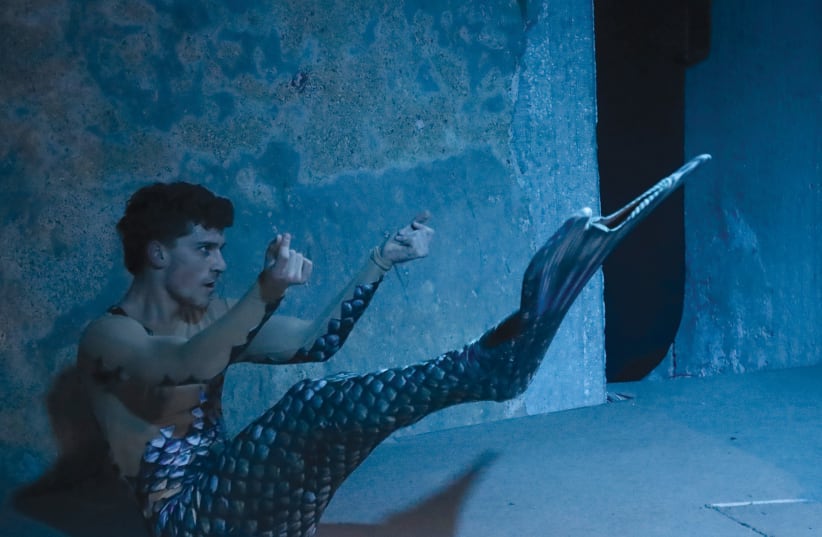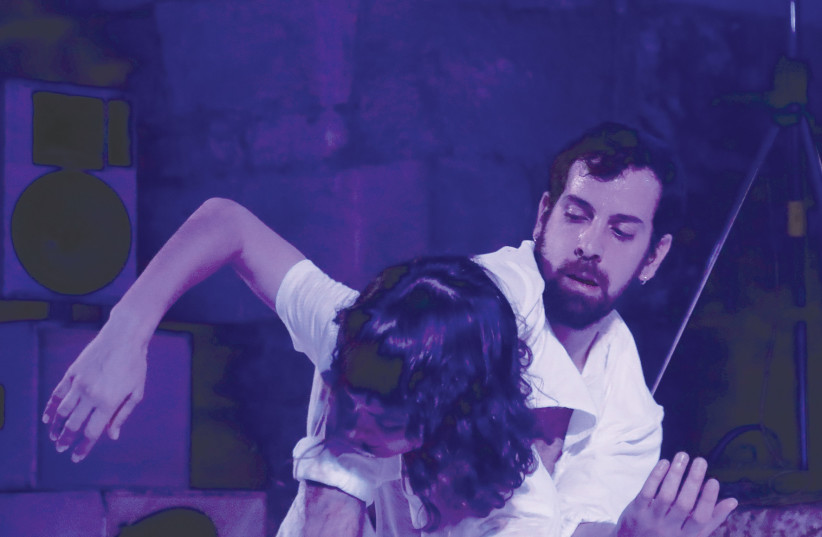Inside the thick medieval walls of the Tower of David, two figures clad in white, one male and the other female, are moving around each other slowly, rolling this way and that to the accompaniment of taped electronic music. At first they seem careful not to touch each other, but slowly, as their movements gather pace, they touch each other’s hands and continue to twist and turn as though executing a form of freestyle dancing. In another small room nearby, two men are interacting in a similar way, moving at first in close harmony, then parting from each other to turn somersaults, against a background of electronic music, this time accompanied by the sounds of birdlike cooing, as though this were an alternative language of communication.
Meanwhile, at the Anna Ticho Artists House, a large man is lying in bed trying to convince his audience that being obese is not a bad thing.
The audiences for these performances are very small. Indeed, the fat man plays a number of times before a handful of people.
Is this dance? Is it performance?
Certainly it is not what these types of art forms used to be. No longer the graceful movements of ballet dancers nor the physical prowess of modern dance groups cavorting to the beat of loud background music. A new style of performance has emerged in recent years, a form that one is hard-pressed to call terpsichorean in any classical sense.
“What we see now is something more intimate, smaller, more audience-related,” says Ido Lahav Noy, director of the c.a.t.a.m.o.n Dance Group, a post he has filled for the past few months. The actual creator of the group is Elad Schechter, who is a dancer and choreographer.
“I’ve been dancing since the age of ten,” says Schechter. Having been through all the usual dance traditions, he found himself moving toward this newer type of performance which “makes possible dance as a cultural language, as well as being a place of meeting for alternative cultures in Jerusalem.” This form of dance “allows the audience free expression through the human body.”
The dance group was founded in Jerusalem’s Katamon district in 2012 when there were, in Schechter’s words, “very few frameworks that were able to support creations in the field of contemporary dance.” Since then, there have been a number of companies which, like his, support the development of this type of dance “that allow for the bodily and conceptual expression in Jerusalem.” In fact, “Since we started,” he says, “we’ve produced 12 works of mine and about 70 original dances that are being presented throughout the world.”
Schechter started with a small number of assistants but decided at some point that he needed a director. Hence Noy, who admits to being neither a dancer nor choreographer. His background is in academia.
“I have a doctorate in medieval Jewish art. My interest is in folklore and customs. I studied at Bezalel School of Art, and then at the Hebrew University. I have curated many exhibitions of Jewish art, including the 2019 Jerusalem Biennale. At some point, I decided I wasn’t really satisfied with academic life. I wanted to make an impact on more people. I saw myself as a director of a cultural institution. In 2008, I began to curate as a freelancer, working with a budget – large or small. I curated the ‘Chamsa’ exhibition at the Islamic Museum for Art, for which I was given a large budget. I was performing all these roles together – as an artist, curator, director, as well as historian and writer. I am about to publish a book on Jewish art. I’m also curating an exhibition on medieval Jewish history in Germany, which will travel to Paris at the end of the year. Recently, I invited seven contemporary Israeli artists that relate to Jewish history. Their exhibition was at the Hebrew University for a year and a half,” says Noy.
“I have a doctorate in medieval Jewish art. My interest is in folklore and customs. I studied at Bezalel School of Art, and then at the Hebrew University. I have curated many exhibitions of Jewish art, including the 2019 Jerusalem Biennale. At some point, I decided I wasn’t really satisfied with academic life. I wanted to make an impact on more people. I saw myself as a director of a cultural institution. In 2008, I began to curate as a freelancer, working with a budget – large or small. I curated the ‘Chamsa’ exhibition at the Islamic Museum for Art, for which I was given a large budget. I was performing all these roles together – as an artist, curator, director, as well as historian and writer. I am about to publish a book on Jewish art. I’m also curating an exhibition on medieval Jewish history in Germany, which will travel to Paris at the end of the year. Recently, I invited seven contemporary Israeli artists that relate to Jewish history. Their exhibition was at the Hebrew University for a year and a half,”
Ido Lahav Noy
So why is he directing c.a.t.a.m.o.n?
“I see a spectrum in art and performance in which ballet is at one extreme. Ballet, though, is for an elite. Dance groups, especially independent ones, do something that is closer to performance than classical dance. What we are trying to do with c.a.t.a.m.o.n is address new audiences. Thus we rarely present our performances in theaters; we look for alternative spaces. Our followers are not classical consumers of dance. They will love art and design in theater and also contemporary dance.
“Sweets, for example, with our overweight actor, accompanied by a harpist, premiered last May at the Brown Hotel in Jerusalem. We brought five people at a time into a hotel room. They sat and watched the show in a highly intimate setting. They were blown away by this experience, feeling that they were dancing with the performer. The actor actually took the audience into the bed with him, tucked them in, and danced with them. He really shared the experience with the audience.
“It is a one-of-a-kind art,” explains Noy. “That’s what fascinates me. Sweets, for example, has been performed in a number of different places, including once at the Israel Museum in front of Magritte’s painting of a castle floating in the sky. In each place, the actor changed the script yet it remained the same work.”
Schechter explains this novel way of presenting his works: “In 2014, we came up with an idea for a festival of dance. We asked how we could expand the concept of an audience and how to expose people to this type of art. Instead of trying to persuade the audience to come to a performance at a theater or gallery, we chose to go to wherever the audience was. We chose the Mahaneh Yehuda market in the center of Jerusalem. Groups of between 10 and 20 people watched performances inside market stalls. The results were extraordinary. It was an eye-opener, since people were not used to seeing marketplaces used in this way.
“We held festivals at the market up to 2020. Dance and market were two things that we connected. Then we were hit by corona, by which time Mahaneh Yehuda was undergoing massive gentrification, so that today it is a center for cultural events. Much of this development is due to our innovative activities. Many other groups similar to ours performed in the market. At one point, though, we realized that we had to leave the market and find a place where we could develop and change. Today, we are looking for places where we can present our dance in alternative spaces. This is a natural development for my work and for the work of those I invite to be guests in the festival.”
From its inception, c.a.t.a.m.o.n was extremely innovative. As Noy puts it: “Typically, to appreciate classical dance you have to be born into the right family, and you are informed about the plot of the work in front of you. What we’re doing is easier for more people to approach. The two performances we just had – one at Anna Ticho House and the other at the Tower of David – saw different audiences. At Migdal David, the audiences were much younger, partly because we also had a night-long party after the performances. But what surprised us was that despite the late hour, the performances were fully booked by young people who I think never attended a contemporary dance show. Most of them were students at Bezalel, the Musrara School of Oriental Music, or the Academy of Music and Dance at The Hebrew University. You could see that they really enjoyed themselves.”
The performers generally come from established contemporary groups, such as Batsheva or Vertigo.
“We draw on chamber dancers,” says Schechter. “We don’t have dancers as employees but try to choose the right dancers for the particular work we want to produce. They are not merely performers, however; they also make decisions in the works they are performing in. They certainly have a say in what they perform, since the creation process that exists between choreographer and dancer is dependent first and foremost on the relationship between the two. There is a very sensitive and wonderful encounter based on mutual trust. The whole choreographic process must be influenced by the dancers who realize the work. I love to work with dancers – that is the essence of my work.
“We receive just enough money to fund duets or trios. We can’t recruit for a larger company. We spend hundreds of hours working on a new presentation. In this recent festival, only a couple of pieces were from the c.a.t.a.m.o.n Dance Group. The governmental support requires us to use creations from outside. Ey Sham and Sweets were my original works, as was the piece by the female solo Palestinian dancer. The others were pieces by other choreographers. In this way, we are able to present other talented assemblages that parallel the values we are trying to promote.”
This year, the company will continue with From Jaffa to Agripas, the name of the recent festival.
“We will stage another festival on Sukkot – in actual sukkot [temporary booths] with dancers and musicians. Some of the other works will take place in hotel rooms, which we call Room Service. Five people at a time will receive a key; as they go into a room and open the door, the concert will start. Later in the year, we’re going abroad – in March to New York City and then on to Mexico, France, and Corsica. The essence of what we are going to do is to tell stories of Jerusalem in our own way,” says Schechter.
By breaking down the traditional barrier between performers and audience, as well as reformulating the idea of a place in which to perform, the c.a.t.a.m.o.n Dance Group has certainly created a radical alternative, and maybe even a new art form. Like many new art forms, this is not easy to absorb. Noy puts says, “Although I have the terminology to speak about it, I don’t fully understand it yet, but I’m not sure that the audience needs to understand everything.”
To which Schechter adds, “I am a great believer in the social change that dance is capable of realizing in the world.” ■

